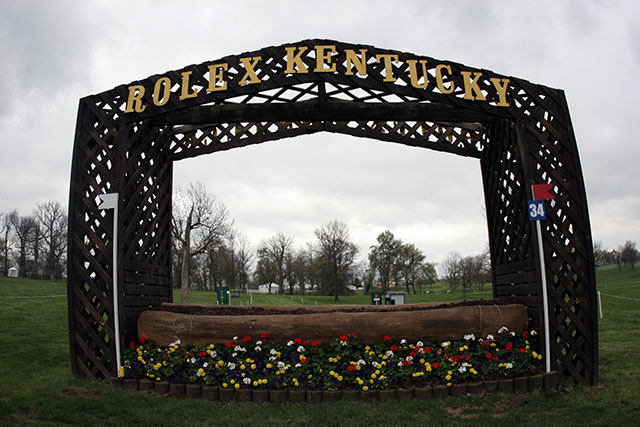 When you walk a Mike Etherington-Smith four-star course, you know what you are going to see—big, inviting, beautifully built, and it will be secretly difficult. Many of Mike’s questions are obvious, and these days our horses and riders have jumped these questions before. But Mike is always mentally one step ahead of the riders, and I think we will see that come into play again this year.
When you walk a Mike Etherington-Smith four-star course, you know what you are going to see—big, inviting, beautifully built, and it will be secretly difficult. Many of Mike’s questions are obvious, and these days our horses and riders have jumped these questions before. But Mike is always mentally one step ahead of the riders, and I think we will see that come into play again this year.
The course starts at the north end of the park behind the Lexington Bank, and there is a very easy, flowing, slightly downhill run to the first fence, the Flower Box. Although this is at maximum height (3’11”), these horses will make it look easy and go for a long, high-speed, downhill turn to the Picnic Table at fence 2.
One of the many subtle things we will see here is that Mike has placed the crowd control rope in such a way as to create a mild, left-hand turn to the second fence. This is a technique that he will repeat throughout this course and indeed most of the courses he designs around the world. The reason for this is that any turn tends to round the horse’s stride and slow the horse, thus the course designer is rounding and slowing the rider’s horse for them, if only the riders will take advantage of that. This fence is built to maximum dimensions, and the unwary may suffer an unfortunate educational experience.
One of my personal criticisms about international course designers in general is that the trend has been to build complicated jumps on level ground. I am gratified to tell you that this year, Mike has used the terrain in very intelligent and sophisticated ways. After the Picnic Table the ground rises gradually towards the east end of the infield. After another mild turn, this time to the right, the riders will jump fences 3 and 4. These are large oxers called the Walnut Tables and should be ridden at a high rate of speed.
What goes up must come down, and the course now comes storming down the center of the infield toward the first serious questions, the Sycamore Corners at 5AB. Mike has sited these corners in a very clever way. First of all, the riders must make a 90-degree turn before approaching the first corner. This is a bit difficult to do after a long, downhill run early in the course, but it will help the riders to put their horses back into a round jumping stride before attempting the first of the corners. In addition, the terrain that Mike has used tips away ever so slightly to the right.
The corners at 5AB are what I call “Red Flag Corners.” This means that any disobedience will tend to be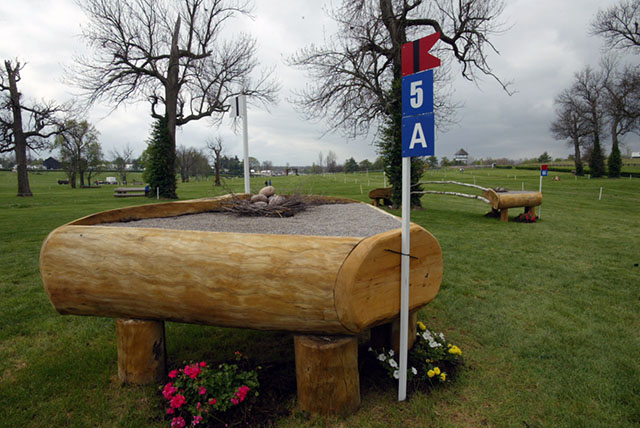 towards the red flag. When you combine the effect of a long, downhill run followed quickly by a 90-degree turn and a left-hand approach, the two corners are far more difficult than some riders may appreciate. The riders are worried about the number of strides, with some of them thinking they can cover 50 feet in two strides, however Mike’s design will require three strides, and I am far more worried about their straightness. The good horses and riders will make nothing of this, and the less experienced are going to suddenly realize why this course designer is who he is.
towards the red flag. When you combine the effect of a long, downhill run followed quickly by a 90-degree turn and a left-hand approach, the two corners are far more difficult than some riders may appreciate. The riders are worried about the number of strides, with some of them thinking they can cover 50 feet in two strides, however Mike’s design will require three strides, and I am far more worried about their straightness. The good horses and riders will make nothing of this, and the less experienced are going to suddenly realize why this course designer is who he is.
From the Sycamore Corners, there is a long run through the infield followed by a downhill, left-hand, sweeping turn to the Trakehner at number 6. This should be jumped at speed, and once again, Mike has used the track of the course to help reorganize the horse before the first water at fence 7ABC, the Poplar Rolls.
This year there is an addition to the Poplar Rolls. There is a half round of almost maximum dimension set one stride from an identical Poplar Roll with a fairly big drop into the water. There is a short line to the right of the mound, but it is a bit jerky and there is not much time to be saved. The vast majority of riders will continue straight ahead after landing in the water and jump a “White Flag Corner” (any disobedience will be toward the white flag).
The distance here will allow for either four forward strides or five quiet strides, and one of the nice things about Mike’s courses is that the number of strides does not matter, but the quality of the balance will be paramount.
I want to point out another hallmark of international course design, and that is the emphasis on symmetrical balance. If you think back for a moment, the Sycamore Corners at fence 5AB tested the horse’s right shoulder. If your horse has a tendency to drift to the right when it jumps, you are going to struggle at fence 5. However at number 7, the test is over the left shoulder, and now Mike is examining the other half of the horse. Modern course design tests both flexibility in terms of increasing and decreasing the horse’s speed and length of stride, and it also tests the honesty of the horse over each shoulder. Later on in the course we will see instances where the horse will be tested over both shoulders at once, but early in the course, Mike isolates and only checks one side or the other.
ADVERTISEMENT
After the corner at 7C, the experienced horses and riders will accelerate quickly because there are several hundred meters before the approach to fence 8 and 9AB, Uncle Frani’s Birch. This is a serious combination. The rail at 8 is very tall and slightly airy. The takeoff is level, but the landing is a steep, 45-degree decline. There is quite a big ditch one stride after the rails at 8, and some of the less experienced horses will lose their concentration at 8. They will try and look at the ditch at 9A before they complete jumping the rail.
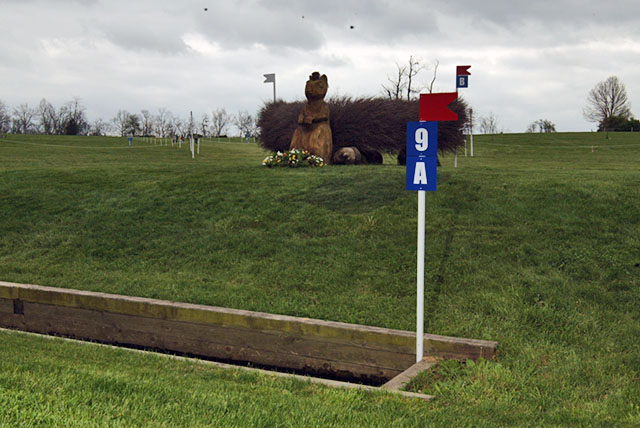 If this is the case, things are going to unravel in a hurry. If the rider has selected the straight line here, he or she must now persevere. The design calls for landing down a steep slope, taking one forward stride, jumping a big ditch, then two uphill strides to quite a tall hedge at 9B. The brushy part of the hedge is 4’7”, which when viewed from the landing after the ditch, appears enormous. Your horse must be balanced, athletic, straight and brave in order to jump this successfully.
If this is the case, things are going to unravel in a hurry. If the rider has selected the straight line here, he or she must now persevere. The design calls for landing down a steep slope, taking one forward stride, jumping a big ditch, then two uphill strides to quite a tall hedge at 9B. The brushy part of the hedge is 4’7”, which when viewed from the landing after the ditch, appears enormous. Your horse must be balanced, athletic, straight and brave in order to jump this successfully.
The construction of the brush here is fantastic. There is a carved squirrel in the center of the fence, and the two brushes simulate the squirrel’s tail. The horses and riders won’t have time to think about that sort of thing, but the spectators and TV cameras will love it. The landing after 9B is on the level, and the riders should quickly accelerate because there is a long uphill pull to fence 10, The Hammock. Mike always refers to this fence as a breather, and my response is always, “yes this is a breather if you think 3’11 high and 6’6’ wide is a breather.”
Bigger Than Before?
Mike is fairly close mouthed about his courses. I asked him yesterday if he thought this course was a little more massive than last year’s course. He avoided a direct answer, but the gleam in his eye after I asked the question leads me to believe that this was his intention. It takes a special horse to jump a series of massive obstacles in a row. There is not a horse on the grounds here this weekend that cannot jump 3’11” by 6’6’, but to do it for more than 10 minutes at a range of speed between slow show jumping and fast steeplechase is a feat that is beyond some of the horses competing here this weekend. Most of the horses here will improve in their morale as they go along, however some of them will show a gradual crumbling of confidence, which will take its toll in the middle and late stages of the course.
After the Hammock, the horses gallop across Mark’s Lane and will approach the new fence at number 11-12, the Ditch and Red Oak Rail. This obstacle has two numbers, but it is designed to be jumped in one effort. There is an enormous, gaping chasm of a ditch in front of a log set at maximum dimensions. If you or your horse have left your courage behind in the start box, you would be well advised to take the long route. However, my guess is that anyone that gets this far will jump the ditch and rail at a high rate of speed and continue galloping toward the Sunken Road at fences 13 and 14ABCD.

The horses have been galloping for nearly a minute at a high rate of speed and jumping with very open strides. The next combination is a test of flexibility and responsiveness of the horse. Although you approach the turn at a high rate of speed, by the time you come out of the corner, your horse must be settled in a quiet, round, balanced, waiting canter.
The rail at fence 13 is high, followed by a bounce step down into the Sunken Road at 14A. The Sunken Road has been redesigned this year. There is a ramp out of the Sunken Road just to the left of the white flag at 14B. The rider must land and make sure that the horse jumps up the bank rather than ducking out to the left up the ramp. The horses then take three strides to a narrow cabin. When I say narrow, I mean that the cabin at 14C is as wide as it is long. This is the first real test of straightness because the opportunity for a runout in either direction exists here. Riders should waste no time accelerating.
They then make a high speed turn to the right and approach an old friend of ours, the Footbridge, which has been relocated here at fence 15. This is an imposing fence, but our four-star horses will make nothing of it. After this the course swings uphill, turns slightly left and jumps another fly fence at 16, the Sheep Shelter. There is quite a drop here, but again the four-star horses will not be affected by it.
At the top of a long uphill pull, there is a table at fence 17, the Pineapple Bar. This fence should be used by the riders as a speed bump rather than a launching ramp. Closely following the Pineapple Bar there is a 180-degree right-hand turn followed by about five strides to approach the Hollow at 18ABC. There is a very steep drop behind the fort at 18A, followed by a 45-degree turn back up out of the hollow to jump a “Red Flag Corner” at 18BC.
Notice that the course design is becoming more complex here now. Do you remember 5AB? A long run followed by a 90-degree turn, followed by a question of straightness. Now, think again about what is being asked here at the hollow. There is quite a big jump followed by a 180-turn, followed immediately by a maximum drop, followed immediately by a bending line to the left to approach a “Red Flag Corner.”
It is more difficult to keep your horse’s right shoulder on a curve to the left than it is to maintain the straightness of your horse’s shoulder in a straight line. Although there is only one corner here, I predict more trouble than there was at 5AB. Both combinations ask the same question, but the approaches to the jumps at 18ABC are far more complex. Just as at most of the other combinations, there is a long way here, but it is so long, that I doubt riders will attempt it unless they are already in difficulty at this obstacle.
The horses turn back to the Horse Park, which is good for their morale, but if they are overly aggressive, this can now lead to trouble. The jump at fence 19A consists of a brush oxer, which is 4’7” at the top of the brush. Done correctly, riders will jump 19A from a medium pace on a slight right to left angle. They will then make a right-hand circular approach back to a brush, “White Flag Corner,” at 19B.
ADVERTISEMENT
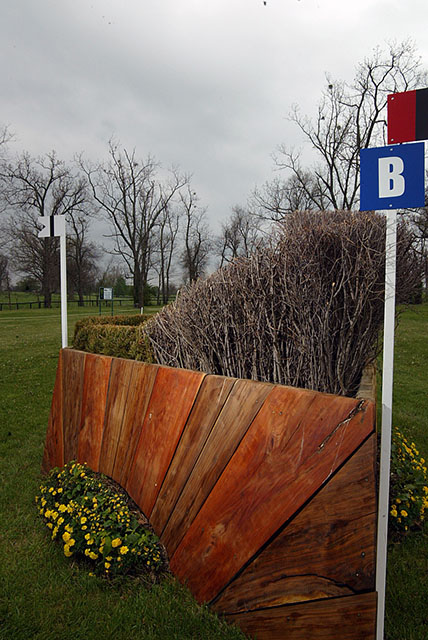 Again, notice the symmetrical nature of Mike’s design. The question at fence 18C was to jump a “Red Flag Corner” off of a left-hand turn. The question at 19B is to jump a “White Flag Corner” off of a right-hand turn. The difficulty is not exactly in the size of the jumps but rather in the sophistication of the questions that are now being asked of these horses and riders. This obstacle will catch out several riders who know better.
Again, notice the symmetrical nature of Mike’s design. The question at fence 18C was to jump a “Red Flag Corner” off of a left-hand turn. The question at 19B is to jump a “White Flag Corner” off of a right-hand turn. The difficulty is not exactly in the size of the jumps but rather in the sophistication of the questions that are now being asked of these horses and riders. This obstacle will catch out several riders who know better.
Following the corner at 19B there is a long run back toward the middle of the horse park, including a new fly fence at 20, the Park Ditch. Riders cross Mark’s Lane again and turn left and downhill toward the dressage warm-up arena and the galloping lane leading to fence 21, the Basket of Flowers. This is another of the beautifully constructed obstacles here but really should cause no trouble.
On To The Lake
As usual, Mike has allowed for a curved approach before jumping into the water at 22ABC-23, the Head of The Lake. The rails at 22 are no bigger than the jump going into the first water at fence 7, but the riders must find the correct pace and stride because there is not a rail one stride before the jump into water to determine their take-off point. Again, the distance across the water to the Lighthouse at 22BC will allow for various numbers of strides. Once again, the number of strides is not nearly so important as the quality of them. Riders should expect that that horses will leave the water and gallop up the bank to the lighthouse quite promptly and bravely, but there will be an instant where the horses will be startled to be asked to jump a narrow lighthouse on top of the island and to return immediately into water. Fence 22BC has no wings, and once again, the opportunity to duck out in either direction is presented.
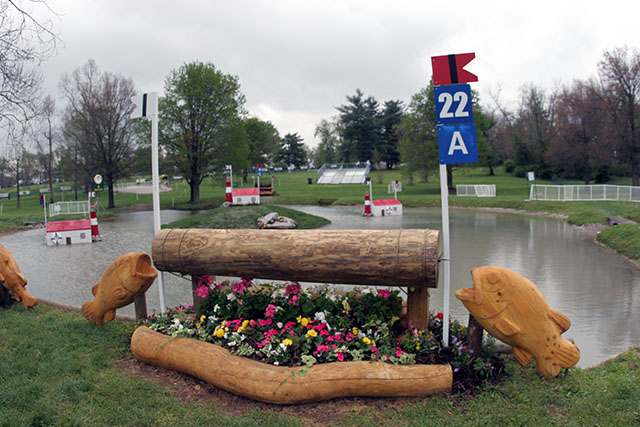
Riders must continue to ride all of the way through this complex. The narrow brush at fence 23 is the repetition of a question that has already been asked, but it is quite big. If the horse and rider are running out of balance after their experiences surmounting the obstacles at the Head of the Lake, they can still come to grief here.
The pressure on the rider’s concentration through this section of the course is unrelenting. Immediately following the tall, narrow brush at fence 23, riders must gather their reins, quickly accelerate forward, and turn to the left in order to gallop to The Creek Oxer at fence 24. This is a fly fence, but if you are patting yourself on the back after fence 23, you will give yourself a kick in the pants after you throw up over fence 24. No matter how big the applause is for you as you exit the Head of the Lake, you must be back in a galloping, attacking frame of mind to jump this enormous oxer.
There is now a long, uphill run to the Normandy Bank at fence 25ABC. Mike has introduced accuracy questions to last year’s test of courage and scope. The riders jump the same ditch and bank on and the same rails off the Normandy Bank, however this year they must make a decision to go slightly right-handed or slightly left-handed and take their choice of triangular brushes at 25 feet.
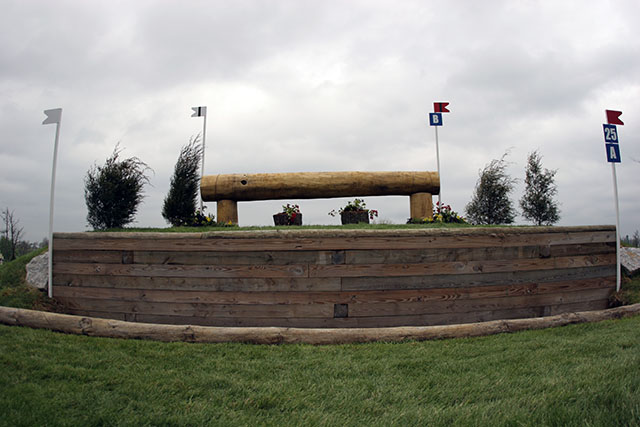 There is no right answer at the Normandy Bank; there is the correct answer for each horse, and I think this fence tells us to a great extent the riders’ knowledge of their horses’ tendencies. Whichever way your horse tends to duck out, you had better go on the opposite direction. My personal preference would be to jump straight ahead and go off slightly to the right narrow brush, because I think that the horse will see this jump sooner. Four-star horses tend to expect these narrow jumps, and I would want them to jump the one they see first. But this is only a slight tendency, and I am sure that both lines will be ridden successfully. Regardless, you can expect this combination to be very influential.
There is no right answer at the Normandy Bank; there is the correct answer for each horse, and I think this fence tells us to a great extent the riders’ knowledge of their horses’ tendencies. Whichever way your horse tends to duck out, you had better go on the opposite direction. My personal preference would be to jump straight ahead and go off slightly to the right narrow brush, because I think that the horse will see this jump sooner. Four-star horses tend to expect these narrow jumps, and I would want them to jump the one they see first. But this is only a slight tendency, and I am sure that both lines will be ridden successfully. Regardless, you can expect this combination to be very influential.
Riders who have been going well will increase their pace as they gallop down across the infield, and they will jump fence 26, the Keepers’ Brush, at a high rate of speed.
Again, there is quite a long run through the infield, followed by a sweeping uphill turn to approach the last truly difficult part of the course at fence 27, The Dray. This obstacle is portable, but it has lived in this general area for four or five years. It is no bigger than many obstacles here, but it rides a bit bigger and over the past several years has caused more than one unfortunate occurrence.
I think this is due to several factors. First of all, there has been quite a lot of galloping and jumping at high rate of speed, and horses are understandably a bit strung out. Second, I do think with horses not expertly prepared, that fatigue has started to become a factor. Short format horses do not become exhausted, but they do run out of air, and this affects their jumping. Finally, I think that riders allow their concentration to wander, and they make the mistake of thinking about what is next rather than concentrating on jumping this large and imposing table at fence 27.
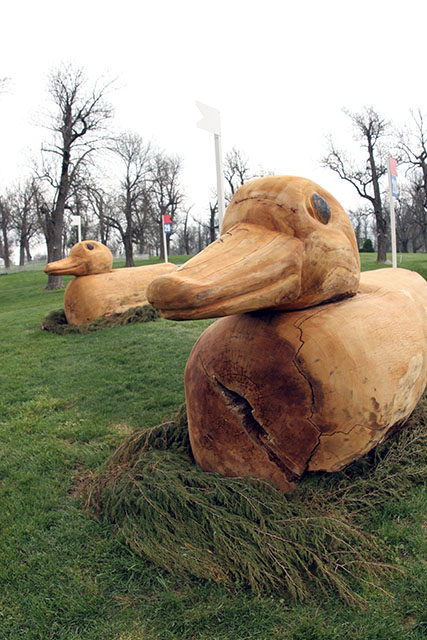
This is another of Mike’s patented, 90-degree turns, then the riders turn uphill to the ducks, which this year have been placed on the top of the bank at fence 28-29. The ducks are set on a slight offset angle, but I don’t think this will matter. The question here is that the distance between the ducks is designed for a horse that lands and continues forward. However, uphill jumps over spread fences tend to make the horse and rider land a little “stuck.” The rider must make sure that the horse jumps the first duck and lands going forward, and then the second duck will be exactly in one stride, and they will jump it easily.
They then make a sweeping, right-hand turn to approach the final water at 30ABC. The fast route involves a very tall, very airy rail on top of a mound. Riders choosing the direct route will land on dry land, gallop down into the final water, and jump yet another duck at 30C. This duck is set at a slight angle. Any loss of concentration at this point in the course will cause a glance-off. There is a long way here, but it takes quite a lot of time. My guess is that anyone with a clean round to this point is going to tackle the straight way. It is the most difficult route here, but even a few time faults can make the difference in your placings on Saturday afternoon.
Leaving the last water jump, the horses gallop into the draught horse field and turn downhill to the Park Log at fence 31. This is big but will be jumped at the gallop, as will the Cross Question at fence 32. There is a ditch under this obstacle, but if your horse jumped the ditch at fences 11-12 confidently, you will aim for the intersection of the rails, and your horse will make nothing of this. There is a mild right turn to a big oxer at fence 33, and then a long, uphill run to the fence all of the riders are looking forward to, the Rolex Arch at number 33, which is the last fence on this almost four-mile course. Horses and riders that gallop through the finish line here with a clean round inside the time will truly have proven that they are among the elite in the eventing world.














